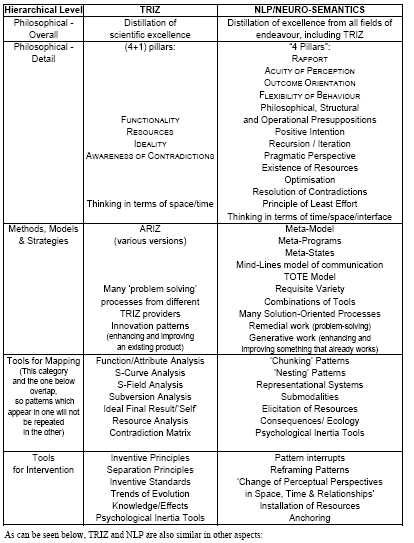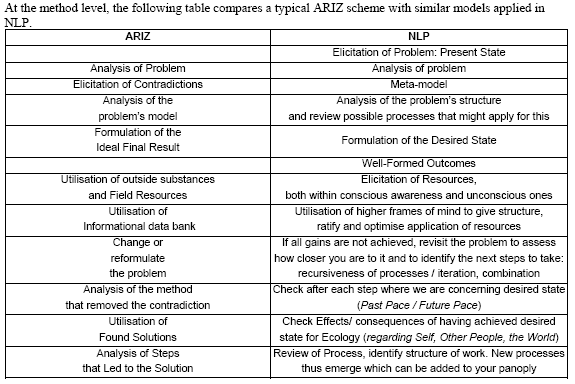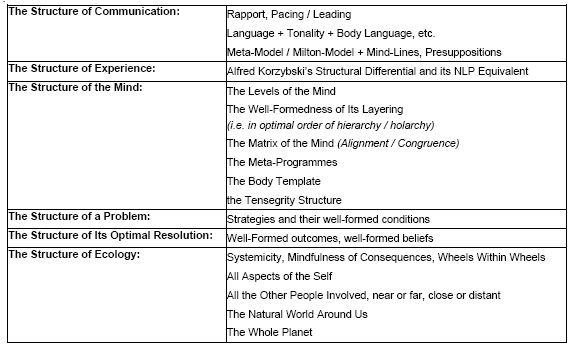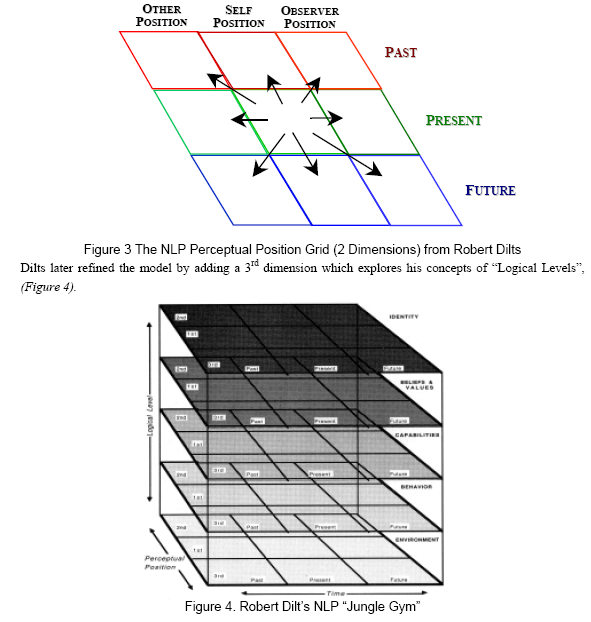Evolving TRIZ Using TRIZ and NLP/Neurosemantics
Editor | On 24, Dec 2002
By: Denis Bridoux and Darrell Mann
Denis Bridoux
NLP & Neuro-Semantics Practitioner
Halifax, UK
Phone: +44 1422 343165
Fax: +44 1422 251296
E-mail: PGPE@outcome.demon.co.uk
Darrell Mann
Industrial Fellow
University of Bath, UK
Phone: +44 (1225) 826465
Fax: +44 (1225) 826928
E-mail: D.L.Mann@bath.ac.uk
ABSTRACT
TRIZ is becoming recognised as the most powerful and complete philosophy available for the definition and solution of technical problems or opportunity situations. As reported by several practitioners, however, TRIZ or more generally ‘systematic creativity’ is still viewed as being at just the beginning of its eventual evolution path. In this paper we discuss the results of our findings when first applying TRIZ trend prediction principles to predict the future evolution of the various tools, methods and strategies contained in today’s versions of TRIZ, and then integrating some of the findings of the parallel-developed Neuro-Linguistic Programming philosophy. We demonstrate significant common ground between the two approaches and many opportunities for mutually beneficial integration.
INTRODUCTION
TRIZ is becoming recognised as the most powerful and complete philosophy available for the definition and solution of technical problems or opportunity situations. As reported by several practitioners, however, TRIZ – or more generally ‘systematic creativity’ – is still viewed as just the beginning of its eventual evolution path. In this paper we discuss the results of our findings to first apply TRIZ trend prediction principles to predict the future evolution of TRIZ’ various tools, methods and strategies themselves, and to then integrate some of the findings of the parallel-developed Neuro-Linguistic Programming/Neuro- Semantic philosophy.
We examine the holistic world-view found in NLP [Reference 1] and compare it with TRIZ. In finding that in many senses NLP offers a more complete framework and that TRIZ contains significantly greater richness in terms of its detailed applications, especially to the physical world, we describe some of the mutual benefits that may be expected to accrue when we combine the two approaches. Among the areas of TRIZ we explore during our evolution prediction and NLP-integration discussion are:
1) A re-examination of the TRIZ Inventive Principles in light of common approaches found in NLP and the way our brains operate, and the emergence of new application heuristics associated with the way systems evolve.
2) An Examination of the benefits we might expect when we combine and integrate the way we apply multiple Inventive Principles to a given problem situation. In particular, we examine the 14 useful effects established in NLP research that are possible when we combine Principles and how they can help us to evolve stronger solution directions.
3) Combination of the TRIZ system operator tool with the equivalent, and in many senses more comprehensive model for viewing problem situation, found in NLP. We build on the initial work reported in this area [Reference 2] to identify further opportunities for enhanced performance of the TRIZ tool through integration with the NLP equivalent.
The future of TRIZ has been the subject of significant discussion in recent times [3, 4] . Opinion differs as to whether it is still at the beginning or has reached the limits of its evolutionary potential. The conflict can be both understood and resolved if TRIZ is recognised as a just a part (albeit a very important one) in a much bigger system. For the sake of providing this bigger system with a label, we will propose the term ‘systematic creativity’.
TRIZ places great importance on the existence of evolutionary S-curves. In these terms, the difference between the s-curve for TRIZ (actually, bearing in mind the different TRIZ proponents and variations, such a TRIZ s-curve should be seen as the averages of a cluster of subtly different s-curves) and an average curve that might be constructed for ‘systematic creativity’ is illustrated in Figure 1. The conflict contained in the question ‘Is TRIZ a mature system or an immature one?’ is thus explained by a point marked on the figure illustrating the current evolutionary state. The point suggests that TRIZ is at the mature end of its evolutionary potential (thus concurring with Vertkin’s comment [4] that ‘there hasn’t been a single new concept introduced into TRIZ in the last 12 years’), but that TRIZ and the current position are still at the relative beginnings of the over-riding ‘systematic creativity’ curve. In terms of ‘systematic creativity’ it is evident that there have been many new concepts emerging in recent times.
Although developed more recently than TRIZ, Neuro-Linguistic Programming/Neuro-Semantics – also shown as an s-curve in Figure 1 – has evolved from a very similar philosophical startpoint. Both TRIZ and NLP have been built on the idea of the studying and abstraction of excellence. In the case of TRIZ, the global scientific and patent databases provided the basis of method development; in the case of NLP it was cognitive science research into linguistics, psychology, cybernetics and anthropology, with specific additional knowledge from psychotherapy – including Gestalt, Rogerian and Family Therapy and Hypnotherapy. Both have sought to study ‘creativity’ from the perspective of modelling known successful creative personalities. They also have drawn from disciplines such as topology or technological models such as lasers and holography, superconductivity and propulsion systems (among others) for useful metaphors of the way our mind works. While NLP can benefit from the tools TRIZ has developed to apply them to the human field, TRIZ, in turn, can make use of the tools NLP has developed to transpose them onto the material world.

The idea that TRIZ is one s-curve (system) inside a bigger system for now called ‘systematic creativity’ emerges from the concept of recursiveness in systems. Recursiveness as discussed in the Viable System Model, NLP and other emerging texts on, not just creativity, but all system evolution is an example of a concept which has not previously been well formed in classical TRIZ. The current prevailing view is that recursion will be an important element in the successful realisation of a ‘systematic creativity’ s-curve. The idea of TRIZ or NLP representing s-curves inside a higher order s-curve explains the s-curve figure constructed by Savransky in reference [3] , which suggests that the next stage of ‘TRIZ’ (but actually ‘systematic creativity’) evolution is the integration of different methods. We suggest that the integration of TRIZ and NLP represents a significant step towards achieving a higher order ‘systematic creativity’ system.
AN OVERVIEW OF NEURO-LINGUISTIC PROGRAMMING
For those involved in TRIZ who are unfamiliar with NLP, it began in the early 70s at Santa Cruz University as the brain-child of two people, Richard Bandler and John Grinder, who were interested in structure and language: computer languages in the case of Richard Bandler, human languages in the case of John Grinder. Mentored by the anthropologist/cyberneticist Gregory Bateson, they drew to them many disciples interested in the structure of excellence and creativity, the foremost of the day being Judith DeLozier (who became Grinder’s wife), Leslie Cameron (who later became Bandler’s wife), Steve & Connirae Andreas and Robert Dilts. These latter three did more than most to endow NLP with a strong methodology in the ‘70s and 80’s. In the 90’s, NLP trainer L. Michael Hall revisited the General Semantics model, developed by the Polish engineer Alfred Korzybski, which was an influence on NLP in its early days. Hall recursively applied it to NLP. The first recursion brought out the Meta-States model.
The second recursion, carried out on the suggestion of one of the authors (Denis Bridoux) led to the emergence of the wider Neuro-Semantics model (NS), which incorporates and encompasses NLP and adds to it an understanding of, and an ability to track and work with, all the upper levels of mind. In its way Neuro-Semantics further develops the initial NLP Scurve and much of the theoretical and practical innovation in the field currently occurs in Neuro-Semantics, including some presented herewith for the first time. By incorporating recursive visits of Gregory Bateson’s approaches, the NS model is also expanding into the modelling of Culture. Both TRIZ and NLP/NS have two mains fields of application [Figure 2] :
1. Problem-Solving (Remedial work)
2. Innovation, Improvement, Enhancement, and possibly Replacement of an existing product (Generative Work).
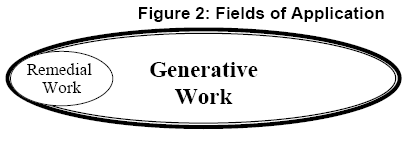
Ideally any resolution of a problem will not just do that, but also offer significant additional improvement and enhancement and contribute to the ideality of other structures above and beyond that directly worked on: it will improve the ideality of the whole system. A more complete overview of NLP/NS and its operational structure is provided in the Appendix at the back of the paper.
AN OVERVIEW COMPARISON BETWEEN TRIZ AND NLP/NS
As already stated, TRIZ and NLP/NS both feature a hierarchy of tools, strategies/methods and philosophies. It is useful to compare the two at each of these levels in order to highlight the similarities and (hopefully beneficial) differences. The following table offers a summary of this comparison at the philosophical, methodological and tool levels.
As can be seen above there are many similarity between NLP/NS and TRIZ/ARIZ. However because NLP traditionally focuses on human beings, organisations, cultures, communities (i.e. biological systems), what is carried out is far more subject to feedback / feed-forward loops than the primarily physical substances that TRIZ has been constructed around.
Key to the Desired State NLP/NS approach to Ideality is the concept of Ecology: this is checked upon and rechecked at every stage, so that it is intrinsic to the Desired State. A desired state which is less than optimally ecological is NOT a desired state.
The concept of Optimality is key also. NLP is not about achieving quantity of result but quality of result. More is not necessarily better, sometimes less is better. However, better IS better. Ideality being an absolute, achieving it would sometimes involve rewriting the laws of nature (or those we are currently aware of), which is not currently feasible. Optimal results will therefore be contingent on time, place, relationships and other contingencies, such as health/money/available knowledge & energy). Optimality is not, therefore an absolute amount, but a ratio which only has meaning in a given space / time / relationship (S/T/R) context. Thus today’s optimality is not necessarily tomorrow’s. In fact, it rarely is. Many of yesterday’s optimal solutions may turn out to be tomorrow’s problems. Extrapolating ecological consequences can enable us to ensure that this need not occur for the foreseeable future or is kept to a strict minimum. However, by being less limited to material/external resources, optimality in the mind is more easily achieved than its body counterpart. Clients are not often aware of this, as our minds are usually modelled upon the templates we begin with, i.e our bodies, and we think that restrictions which apply to the body necessarily applies to the mind, which is not always the case.
Another implication of this approach is Congruence: this means seeking and reaching consensus, harmony, agreement between all the components of a given system, so that desired outcomes are met between all parts of this system, for the benefit of all and at the expense of none, thus enabling true ‘win-win’ situations. This is achieved not only by resolving all the contradictions identified as part of a problem, but also the lesser ones which would reduce the impact or effectiveness of a result. Indeed, NLP has amply been demonstrating such effectiveness in the area of team building, management, mediation, conflict resolution and partnership guidance for the past 30 years.
NLP places great importance on Structure: of Subjective Experience, of Excellence, of the Mind, of a Problem (Present State), of its Optimal Resolution (Desired State), of the Process to attain it (Strategy Models), of Intentionality. Key to this is the notion of Well-formedness. If a structure does not operate properly, its well-formedness is less than optimal.
USING NLP TO RE-STRUCTURE THE 40 INVENTIVE PRINCIPLES
For many users, the 40 Inventive Principles are a very effective series of solution triggers. Used at this fairly basic level, they may be seen as a more comprehensive version of the SCAMMPERR model developed by Osborn [6] . The problem with the 40 Principles for many newcomers, however is that 40 is a lot of triggers to remember. Most people keep a list with them, but the bigger issue is that our brains are wired with a short term memory store capable of storing only around about 7 different pieces of information [7] . Actually 7 ± 2. We wondered, therefore whether it would be possible to re-configure the 40 Principles into a structure that would ease our ability to remember them. As we progressed, incorporating NLP thinking and the SCAMMPERR1 model (see also Savransky [3] ), we believe we would be able to not only achieve this, but also enrich the quality of the Principles.
In the first instance, we saw the space-time-interface dimensional thinking concept as an important start point.
COMBINED TRIZ PLUS NLP ‘SYSTEM OPERATOR’
By way of a simple example of some of the other benefits we might expect to accrue through combined
application of TRIZ and NLP by exploring developments to the TRIZ 9-window system operator, an
independently developed NLP variant of which was developed by Robert Dilts in the 80s (figure 3).
Reference 9 discusses how by relating the two systems, NLP has been used to extend the TRIZ System Operator’s essentially two-dimensional space and time perspective into a third dimension which is called ‘relationship’ in NLP and which we might appropriately call ‘interface’ in TRIZ. Figure 6 illustrates this new three-dimensional system operator as an example of a concept that exists in neither TRIZ or NLP, but emerges purely from the integration of the two.
Many will have noticed how some of the Principles can indeed be related to all three dimensions – Segmentation, for example, can be applied as a contradiction breaking strategy with respect to physical segmentation, segmentation of time (see also ‘Periodic Action’) and segmentation of the interfaces between things. We also noted that some Principles had analogues that reversed the Principle – e.g. ‘Segmentation’ and ‘Merging’ are often interpreted as two opposites. Some on the other hand didn’t – Asymmetry being one such example. When asking the question ‘would it be possible to challenge a contradiction by making something symmetrical instead of asymmetrical?’, we answered with a definitive yes. The opposite can also occur, balance and proportion then becoming important factors. The same happened with many other Principles.
Next we looked at our space-time-and interface entities and saw that within each category, all of the Principles grouped into just five different strategies for modifying a system :-
1) Segment or merge (i.e. change the number of entities)
2) Make the entities bigger or smaller
3) Change the external geometry
4) Change the internal structure
5) Substitute the existing structure for something else.
We then found that the existing Principles fitted very neatly into a 5×3 matrix as illustrated below (figure 6):
The figure diagonally divides each box to illustrate that every one has both its positive and negative sense. It also illustrates the relative position of each of the 40 Principles within the structure. Thus Principle 13 – the other way around – now features implicitly in each element of the Principle Matrix.
Actually, we found two other special case Principles that did not fit into the Matrix, but fitted instead into the higher order philosophical level. These were:-
25 Self-Service – This is a Principle which is highly connected to the Ideality concept We note that the Principle does not appear in the classical TRIZ matrix nearly as often as an ideality-driven thought process would lead.
22 Blessing in Disguise – in a similar vein, this Principle encourages users to think about the resources element of the TRIZ philosophy.
Again it does not feature in the classic Contradiction Matrix nearly as often as its use in a bigger context would demand.
In examining the SCAMMPERR model in more detail, we found that while 8 of the 9 strategies in the model were covered by the Inventive Principles and by the 5×3 matrix framework above, the ‘P’ – ‘put to another use’ was not. In SCAMMPERR, this trigger encourages users to solve problems by changing function. This is not normal TRIZ practice, but, again, when we asked the question ‘would it be possible to challenge a contradiction by changing function, the answer was an unqualified ‘yes’. Taken together with the above
Principles 22 and 25, we believe this ‘change function’ Principle forms a useful third entry in a trio of
special Principles linked directly to the five philosophical strands of TRIZ. I.e.
Functionality – Change Function
Resources – Blessing in Disguise
Ideality – Self-Service
Space/Time – New 5×3 Matrix
Contradictions – New 5×3 Matrix
So, we found it was not possible to quite achieve the 7±2 model – having 3 special Principles plus 8 labels for the Matrix. But what we did have was a system that features significantly greater richness than the 40 Principles. The 40 Principles for example do not explicitly suggest that making a thing physically bigger or smaller is a way of solving a contradiction (although Principle 21 – Hurrying does so in the time dimension – see figure). Similarly, some of the 40 Principles (e.g. Local Quality and Asymmetry) are traditionally directed towards physical things – whereas in each case there are very definite time and interface analogies of the Principle.
Thus (SPACE-TIME-INTERFACE) + (SEGMENT, SIZE, SHAPE, STRUCTURE, SUBSTITUTE) + (FUNCTION-IDEALITY-RESOURCES) – SIT-5S-FIR – provides a means of remembering a richer, more structured version of the 40 Principles. Or (more closely related to a start-point at the 5 main philosophical elements): FUNCTIONALITY-IDEALITY-RESOURCES-(SPACE-TIME-INTERFACE)-CONTRADICTIONS | 5S
USING THE PRINCIPLES MORE EFFECTIVELY WITH NLP/Neuro-Semantics:
COMBINATORIAL & CYBERNETIC EFFECTS
If we observe what is happening above with respect to combining Principle 13 with each of the other Principles and the combination of Principles that often happens when we have physical contradictions separable in both time and space (8), it is possible to see that the combination of Principles is a potentially important problem solving strategy. This fits, of course, with the Mono-Bi-Poly evolution trend. With respect to combinations of strategies, it would appear that NLP/Neuro-Semantics has significantly greater richness from which TRIZ users might benefit: When applying one state upon another, or one process upon another in Neuro-Semantics®, the following range of interactions can result:
* The original is stopped
* The original is neutralized
* The original is made transient
* The original is diminished
* The original is strengthened
* The original is distorted
* The original is qualified
* The original is made solidified/made permanent
* The two states are confused
* An unexpected result occurs
* A paradoxical result occurs
* A new process is generated
* An emergence occurs
The order in which processes are carried out is key to effectiveness, as each one qualifies and modulates the previous ones.
Clearly, from the perspective of using the 40 Principles in combination with one another, it is the latter four of the 13 possible outcomes outlined above that will have the most beneficial impact on the creative solution obtained. The 5×3 Matrix structure provides a useful means of identifying which combinations of Principles are likely to present such beneficial effects. Obviously Principle 13 is present throughout the Matrix and is likely to give a positive combinatorial effect. The same applies to the higher level Change Function, Blessing in Disguise and Self-Service Principles. For the others, there appears to be a strong demarcation between the space, time and interface side of the matrix; such that, for example, if a given contradiction is solely space related (e.g. area versus length) then there is unlikely to be a beneficial combination of Principles featuring in the time and interface columns of the 5×3 matrix; whereas a contradiction like strength versus duration of action implies a possible connection to space, time and interface issues, and thus all Principles may present opportunities for synergistic combination.
We are often mindful of the positive consequences of an action, less often of its negative consequences, and even less often of an inaction and its consequences. NLP charts this using the Cartesian grid illustrated in Figure 3.

This can be represented by a cubic grid, instead of square one. For a clear understanding of its structure, we have separated its subcomponent cubes below.

FURTHER AHEAD
The integration of TRIZ and NLP tools, methods and philosophies (both of which rightly claim to feature such hierarchies of application) is very much at the beginning of what may be expected to be a long and mutually enriching journey of discovery. Several important conceptual advances can be expected to emerge. We have hopefully hinted at a few here, and also demonstrated how integration has produced some interesting and potentially highly beneficial new perspectives on basic but important TRIZ tools.
REFERENCES
1) Bridoux, D., ‘Seven Steps To Emotional Intelligence’, 2001.
2) Mann, D.L., ‘System Operator Tutorial: 3) Another Dimension’, TRIZ Journal, December 2001.
3) Savransky, S., ‘Engineering of Creativity’, CRC Press, 2000.
4) Vertkin, I., ‘TRIZ Development From The Past Into The Future’, keynote address at TRIZ Future 2001
conference, Bath, November 2001.
5) Mann, D.L., ‘Towards A Generic, Systematic Problem-Solving and Innovative Design Methodology’, paper
presented at 12th ASME DETC Conference, Maryland, September 2000.
6) Osborn, A.F., ‘Applied Imagination: Principles and Procedures of Creative Problem-Solving’, Scribners,1963.
7) Miller, G.A., ‘The Magical Number Seven, Plus or Minus Two: Some Limits on Our Capacity for Processing
Information’, originally published in The Psychological Review, 1956, vol. 63, pp. 81-97
8) Mann, D.L., ‘Contradictions Separated in Time AND Space’, TRIZ Journal, June 2001.
9) Mann, D.L., ‘System Operator Tutorial 3) Another Dimension’, TRIZ Journal, December 2001.
THE NEURO-SEMANTICS® MODEL
© 2002 L. Michael Hall / Denis Bridoux
Meta-States operate as the inner Executive Programs & Structures which govern our being, functioning,
perceiving, thinking, feeling, speaking, behaving, etc.
Meta-States also operate as our higher levels of references & information. They therefore function as
attractors in a self-organising system.
Meta-States as Higher Frames of Mind: All Thoughts-Feelings (T-F) occur in some frame-of-reference.
This creates our primary frame of representation, our meta-level frames, and our ever more abstract
Conceptual Frames.



